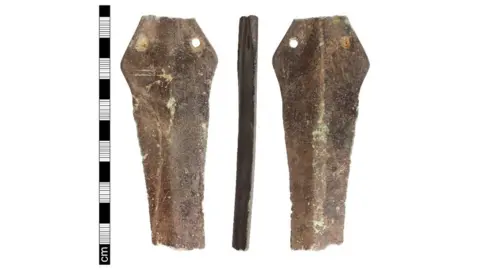Bronze Age sword piece found in Norfolk linked to hoard
 Portable Antiquities Scheme
Portable Antiquities SchemeExperts say a sword fragment will help them better understand the "practice of hoarding" in the Bronze Age.
The item, discovered on Norfolk farmland in 2018, is missing its hilt and much of its body and is just 11cm (4in) long.
The weapon is believed to date from between 900 to 800 BC.
Historians are linking the find to fragments of knives and axe heads found in the same area in 2009 and in 2016.
Julie Shoemark, finds liaison officer with Norfolk County Council, said: "It is very likely, given the date of the artefact and relative proximity to the previously reported artefacts, that this fragment derives from the same original deposit."
She said hoards could sometimes be struck by agricultural machinery, spreading them over several hundred metres and resulting in their recovery over several years.

Bronze Age history
- True bronze is a combination of 10% tin and 90% copper with both materials readily available in Britain at this time
- The late Bronze Age saw more sophisticated weapon-making
- According to the British Museum, early hoards are widely accepted as being deposited as part of ritual practices
- Later hoards were seen as a response to the threat of invasion or economic upheaval

The sword fragment has been declared treasure and it is hoped it will join two other finds acquired by Norwich Castle Museum.
Anyone who finds gold or silver artefacts thought to be more than 300 years old must report them to the coroner.